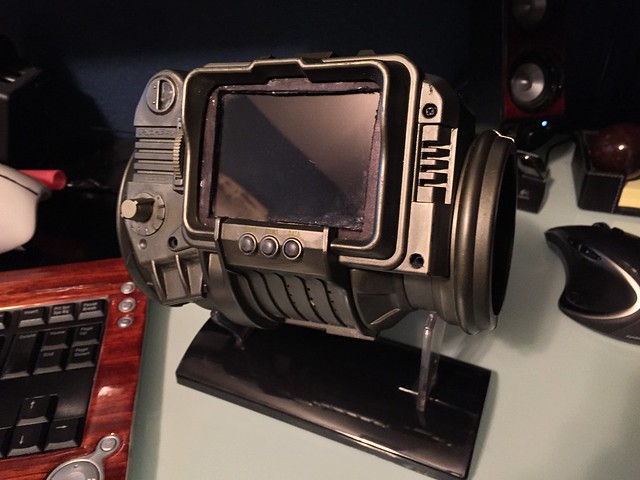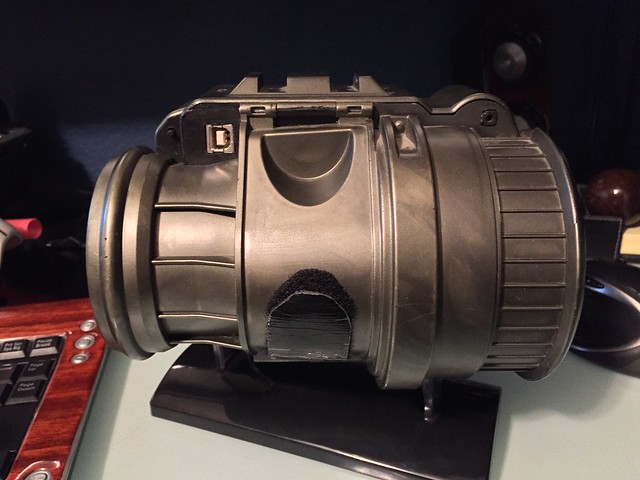SLS 3D printed Nylon is solid, although all Nylon does absorb moisture, but the material is effectively as waterproof as any other plastic.
However, making something like the Pip-Boy water proof is a VERY tall order. Some of the knobs can be sealed with O-Rings, but that also makes them prone to binding up. But the scroll wheel knob couldn't be waterproofed and still turn a gear. The LCD screen can be made water-resistant to light rain with a simple adhesive gasket, but it can't be made waterproof due to the waterpressure against the large surface area of the screen. The tactic button uses don't have enough force to overcome a gasket, and you won't find small waterproof or even resistant buttons. The speaker vent would have to be covered with plastic and wouldn't work well. Finally there is the matter of the gaping hole where you arm goes through, the simplest way here would be to try to seal the the person's arm, but again there is the bottom latch seam which would be difficult to seal up.
------------------------------
Project update, no images:
Currently I am working on the tedious task that is researching, and selecting electrical components. I am starting with the most difficult part, which is the LCD. The circuit which can drive one LCD screen doesn't necessarily work on another. Different screens have different ways to get the data to the screen. Then there is the task of voltage boost converters which take the 3.7V from a lithium polymer battery and boost it to the 19.2V that the screen backlight requires. Add to that modeling connectors and creating schematic symbols and you have a lot of time just preparing to design the schematic.
I have started using KiCAD to do the schematic and PCB. It seems this year they have fixed a lot of the grips that kept people from recommending it in the past. Why am I not using Eagle? Because my main board is bigger then microscopic 100mm limit that Eagle Free allows. I also will most likely need four layers for the PCB. I considered using Design Spark as it is also free, however I got stuck for hours just trying to make the most basic part footprints. Apparently, in DesignSpark you can draw a line, but you can't edit it easily. If the most basic task was impossible I wasn't going to try the harder stuff in it.
The next hardest task will be the gauge motor, it requires a stepper motor controller and its own voltage boost to work well. Stepper's are not something I have worked with in the past. So I am researching and learning as I go.
This is unfortunately the slow part of the project without any pretty renderings to show you all. I am expanding the bill-of-material estimate as I add major electronics parts. It is nearing $1000, but when I build my prototypes it will cost me at least $1500 to build the first one. $200 of that alone is left over costs in minimum order quantities.
With that said, I have added a Paypal donate button to my website if anyone is interested in helping fund the prototype build.
However, making something like the Pip-Boy water proof is a VERY tall order. Some of the knobs can be sealed with O-Rings, but that also makes them prone to binding up. But the scroll wheel knob couldn't be waterproofed and still turn a gear. The LCD screen can be made water-resistant to light rain with a simple adhesive gasket, but it can't be made waterproof due to the waterpressure against the large surface area of the screen. The tactic button uses don't have enough force to overcome a gasket, and you won't find small waterproof or even resistant buttons. The speaker vent would have to be covered with plastic and wouldn't work well. Finally there is the matter of the gaping hole where you arm goes through, the simplest way here would be to try to seal the the person's arm, but again there is the bottom latch seam which would be difficult to seal up.
------------------------------
Project update, no images:
Currently I am working on the tedious task that is researching, and selecting electrical components. I am starting with the most difficult part, which is the LCD. The circuit which can drive one LCD screen doesn't necessarily work on another. Different screens have different ways to get the data to the screen. Then there is the task of voltage boost converters which take the 3.7V from a lithium polymer battery and boost it to the 19.2V that the screen backlight requires. Add to that modeling connectors and creating schematic symbols and you have a lot of time just preparing to design the schematic.
I have started using KiCAD to do the schematic and PCB. It seems this year they have fixed a lot of the grips that kept people from recommending it in the past. Why am I not using Eagle? Because my main board is bigger then microscopic 100mm limit that Eagle Free allows. I also will most likely need four layers for the PCB. I considered using Design Spark as it is also free, however I got stuck for hours just trying to make the most basic part footprints. Apparently, in DesignSpark you can draw a line, but you can't edit it easily. If the most basic task was impossible I wasn't going to try the harder stuff in it.
The next hardest task will be the gauge motor, it requires a stepper motor controller and its own voltage boost to work well. Stepper's are not something I have worked with in the past. So I am researching and learning as I go.
This is unfortunately the slow part of the project without any pretty renderings to show you all. I am expanding the bill-of-material estimate as I add major electronics parts. It is nearing $1000, but when I build my prototypes it will cost me at least $1500 to build the first one. $200 of that alone is left over costs in minimum order quantities.
With that said, I have added a Paypal donate button to my website if anyone is interested in helping fund the prototype build.



